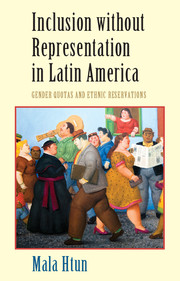Book contents
- Frontmatter
- Dedication
- Contents
- List of Tables and Figures
- Preface and Acknowledgments
- List of Acronyms
- 1 Introduction: Politics of Inclusion in Latin America
- 2 Women, Afrodescendants, and Indigenous Peoples in Elected Office
- 3 Gender Quotas: Why and How?
- 4 Indigenous Reservations and Gender Parity in Bolivia (written with Juan Pablo Ossa)
- 5 Political Inclusion in Colombia
- 6 Brazil: Combatting Exclusion through Quotas in Higher Education
- 7 After Quotas: Women's Presence and Legislative Behavior in Argentina (written with Marina Lacalle and Juan Pablo Micozzi)
- 8 Conclusion
- Appendix 1 Research Trips
- Appendix 2 Mechanisms of Inclusion
- References
- Index
3 - Gender Quotas: Why and How?
Published online by Cambridge University Press: 18 December 2015
- Frontmatter
- Dedication
- Contents
- List of Tables and Figures
- Preface and Acknowledgments
- List of Acronyms
- 1 Introduction: Politics of Inclusion in Latin America
- 2 Women, Afrodescendants, and Indigenous Peoples in Elected Office
- 3 Gender Quotas: Why and How?
- 4 Indigenous Reservations and Gender Parity in Bolivia (written with Juan Pablo Ossa)
- 5 Political Inclusion in Colombia
- 6 Brazil: Combatting Exclusion through Quotas in Higher Education
- 7 After Quotas: Women's Presence and Legislative Behavior in Argentina (written with Marina Lacalle and Juan Pablo Micozzi)
- 8 Conclusion
- Appendix 1 Research Trips
- Appendix 2 Mechanisms of Inclusion
- References
- Index
Summary
In 1991, Argentina became the first country in the world to introduce a gender candidate quota to national electoral legislation. Since then, fifteen other Latin American countries followed suit (though Venezuela subsequently revoked the law). In 2014, the median country in the region – fifteen of nineteen, or 79 percent – applied gender quotas in every election. Not all the laws are perfect: in the years after adoption, many underwent reforms to facilitate implementation, add sanctions for noncompliance, and raise target percentages (see Table 2.6). Overall, the policies have led to major gains in women's presence in power in some countries; in others, the results have been less impressive.
Latin America's embrace of gender quotas led world trends. Overall, some fifty-six countries (and two polities – Kosovo and the Palestinian Authority) have national laws guaranteeing women's inclusion in politics through candidate quotas or reserved seats. Some forty-five countries apply such guarantees at the local level (Paxton & Hughes, 2013).
Why are so many countries adopting quotas? What is the problem that the policies are responding to? Why did some countries, but not others, introduce these measures? Did they succeed in getting more women elected? In a fascinating book, Ann Towns argues that the status of women has become a measure of civilization and a way to “evaluate and rank states in a hierarchical manner” (Towns, 2010, p. 6). Countries interested in improving their status in international society must attempt visibly to demonstrate their efforts to improve the condition of women. Policies like gender quotas offer a means for states to ascend in the global hierarchy. They adopt quotas to seem modern and to prove their credentials on democracy and human rights. In an earlier era, by contrast, it was the opposite phenomenon–women's political exclusion– that constituted an international status symbol. “Civilized” states kept women out of politics (Ibid., chapter 4).
The emergence of gender quotas as a “standard of modernity” may be a necessary condition for policy adoption. But it is not sufficient. Many more states are affected by, and participate in, international society than have quota policies. International norms and hierarchies are thus an important part of the explanation for quotas but do not adequately distinguish between adopters and nonadopters. To explain variation in policy patterns, we need to look at the political agency of women politicians.
- Type
- Chapter
- Information
- Inclusion without Representation in Latin AmericaGender Quotas and Ethnic Reservations, pp. 44 - 69Publisher: Cambridge University PressPrint publication year: 2016

